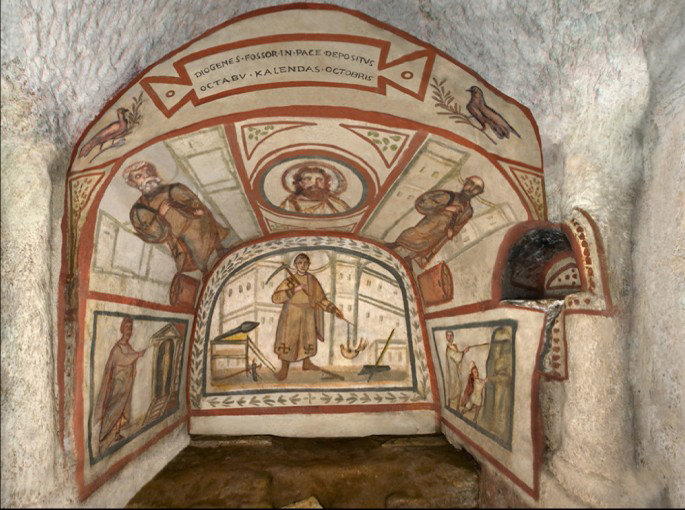1. Introduction to Inscriptions
Purpose, Function, and Meaning
Inscriptions are words or images that are cut, scratched, or painted onto stone, glass, metal, brick, or plaster. They are some of the oldest texts that we have. The study of inscriptions is usually referred to as “Epigraphy”. Often inscriptions as a source category are put in contrast to texts and images that appear in manuscripts (on parchment), in papyri, or in books (on paper). The study of scripts, often in manuscripts is "Palaeography", while the study of manuscripts themselves is "Codicology". However, these divisions can be somewhat arbitrary. For example, the text in the front of a book is also called an “inscription” (although in this e-learning tool chapter, we will consider inscriptions in the sense of texts which are found outside books or manuscripts), partly due to the commemorative function of these texts, which is common in inscriptions on stone or metal. Equally, separating a text from either manuscript, epigraphic, or book form is not always possible. For example, sometimes the sole copy of a text that was originally an inscription now only exists in manuscript form. Moreover, often texts that are predominantly transmitted in manuscript form are also found on inscribed material.
In other words, lines between inscribed and non-inscribed texts are often much more porous than might be suggested by the way in which editions of inscriptions or manuscripts might suggest. In this e-learning tool chapter, we will consider the function, purpose, and production of inscriptions; we will identify the common formulae and phrases of inscriptions, and then we will examine this porosity between inscribed and non-inscribed sources through the example of Biblical quotations on ancient Jewish inscriptions, before finally questioning the role that language may play in bilingual and even trilingual inscriptions. This section on inscriptions aims to provide a different philological perspective, and provide some methods and theories to enable you to work with epigraphic materials in the future. One of the questions at the core of this chapter is whether it is possible to have stark divisions between categories of sources. Furthermore, how can looking at different categories of sources contribute to our understanding of texts?

Inscriptions can have a variety of functions. They can be commemorative, such as on gravestones, or on war memorials. These texts act as reminders to those who see them of the individuals that have been lost, or the atrocities that have occurred. Inscriptions can also be devotional, such as for saints, or on wedding rings. Among other things, these inscriptions might aim to say “I am here and this is important to me”. Inscriptions are usually either related to the material in which they are inscribed, such as one’s own name inscribed on an object to indicate ownership, or they might be exist solely for the information that they contain, such as an ancient legal decree inscribed in marble for those are affected by it to see it.
In reality, one cannot separate the text from the object, or the function of the inscription from its meaning. This is something that you must always remember while working with inscriptions: the material becomes part of the text and influences its meaning and reception. Each of these examples outlined above can have more than one function. For example, a gravestone may be both commemorative and devotional. Equally, a marble plaque of an emperor’s new law may not only be conveying information, but also its own existence indicates a power structure and a kind of ownership, not only of the marble on which it is inscribed, but also of its audience. For names inscribed in sacred spaces, such as in churches by medieval Christians, there is no ownership indicated, but the content of the name is almost just as important as the material upon which the text is written.
Inscriptions as Philological Texts
Where broad definitions of other disciplines (Epigraphy, Codicology, and Palaeography) have been outlined relatively easily above, "Philology" as a discipline is harder to define, and can mean different things in different contexts. In this chapter, Philology is understood in its broadest sense of "how to make sense of texts" (Pollock 2015, 1). The ways and methods Philology might be applied to texts varies. As we will explore in this e-learning chapter on epitaphs, inscriptions are highly formulaic texts, with their own grammatical and even orthographic practices. These epigraphic practices pose their own array of problems that require Philological study in order to understand their meaning.
Consider an inscription that could read:
In loving memory of [name], who lived XX years, and will forever be missed.
What would this short text tell us about the worldview of the individual commemorated, the one who wrote the inscription, and the individuals that look upon the stone? How do we understanding "memory", "missing", and "forever" in this context? Have Roman numerals, rather than "20", been written for stylistic and/or visual reasons, or because they add another kind of meaning?
These kinds of questions are those that epigraphists/philologists might first ask when looking at an inscription. The purpose or function and the meaning of the inscription provide a small insight into the worldview or values of individuals and communities. Using philological practices in epigraphy assist in the accessing of this information, which is one of the focuses of this e-learning chapter.

St Domitilla, Christian Catacomb in Rome
To summarise:
- Inscriptions are texts that are also material objects, and their meaning is affected by this materiality.
- Stark separations between inscriptions and other types of texts is not usually possible, just as separating the function and purpose of inscription into tight categories is often unhelpful because they usually aim to do several things.
- A multi- or inter-disciplinary approach is important to study inscriptions, if one is trying to access their meaning. This means, for example, using practices from Philology.